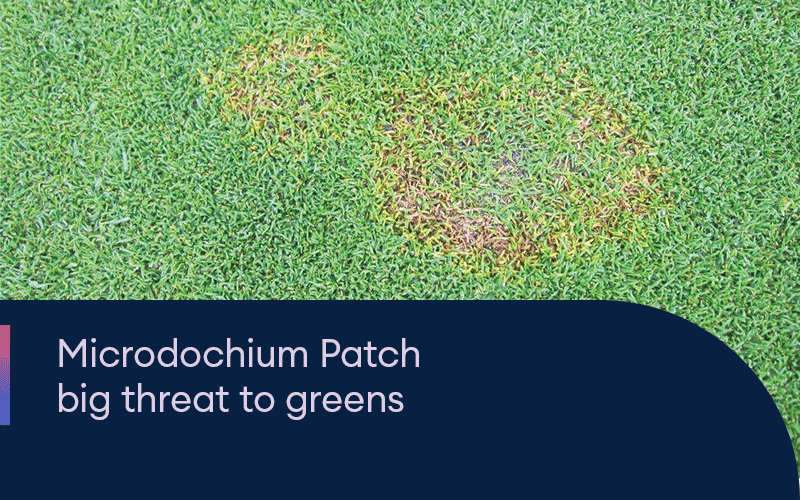Microdochium Patch Big Threat to Greens
Wet autumns can set us up for a nasty year of microdochium patch starting in the spring. Save your greens by scouting early. Heavy rainfall in the fall can make it difficult for golf course superintendents to get a proper fungicide application before grass went into full dormancy. Precipitation can often affect contact fungicides more than systemics. Even if you did squeeze in a spray, the heavy rains that followed could compromise the longevity of the fungicide applications come spring.
Identifying microdochium patch
Microdochium patch, also known as fusarium patch or pink snow mould, appears as small, circular dead spots (up to several inches in diameter). The spots are often slightly pink with fluffy white mycelia evident in the early morning. The fungus can survive on plant debris and cover dead plant tissue with pink spore masses. It becomes more difficult to identify as the season progresses but early in the spring it’s easier to see as it’s one of the only diseases you’re facing.
As microdochium patch is one of the first diseases to show up in April and May, it’s best controlled in the fall with a preventive application. It can be tough to get a sprayer out on the course in a cold and wet spring.
Wet autum weather can make it very difficult to spary. It’s estimated that more than 50 per cent of golf courses in Eastern Canada could be facing heavy microdochium patch pressure this spring. Superintendents need to pay special attention when scouting. A microdochium patch outbreak on golf greens can be especially devastating.
A wet, cool spring won’t help
In wet spring conditions where the daytime temperature stays between 7 C and 20 C the disease can explode, especially when it’s overcast, foggy or wet. The disease especially likes shaded or poorly drained areas.
If you see microdochium patch at the end of March and early April, you may have to pull the trigger on a clean-up or preventive fungicide application earlier than you’d planned. Once it catches hold, it can be difficult to get rid of microdochium patch, and it can take a long time for the turf to grow out of disease. Often the turf won’t heal until later in May.
You find microdochium patch. Now what?
Getting the leaf tissue dry helps reduce disease pressure. Try dew whipping and rolling when conditions allow you to get out on the course. Reducing the amount of thatch helps too.
If you’re facing significant pressure and it’s still less than 7 C daytime temperatures, spray should include a quality DMI formulation fungicide as it will perform faster than other chemistry classes such as SDHI or QoI fungicides alone.
Dedicate® Stressgard® Formulation Technology provides excellent preventive and curative activity on microdochium patch. Dedicate can also help turf recover from pink snow mould damage following snow melt.
Dedicate Stressgard at 32-64 mL per 100 sq. m can be used as a preventive or early curative treatment. In very early curative situations when temperatures are below 4 C with high disease pressure, tank-mixing Dedicate Stressgard with a contact fungicide (such as chlorothalonil) can help protect the plant while breaking dormancy and facilitating DMI uptake into plant. Rotate applications with non-dicarboximide or SDHI fungicide products when multiple applications are used in the season for microdochium patch control to discourage resistance development.
Once it’s above 4 C, Dedicate Stressgard already combines a high quality DMI with a QoI for enhanced protection.
Patience pays
If you have a big outbreak of microdochium patch in the spring, the plant won’t be metabolizing enough to recover. What would normally take a plant three to four days to grow through could take three to four weeks.
Your inclination might be to reapply a fungicide within a few days when you don’t see any results. Don’t do it. Wait.
The same goes for fertilizer. Balanced fertility is key to managing microdochium patch. If you try and help the turf grow out of the disease pressure with fertilizer, all the nitrogen in the soil will explode and cause more problems when the temperature finally does start to spike.
ALWAYS READ AND FOLLOW PESTICIDE LABEL DIRECTIONS. Envu, the Envu logo, Dedicate® Stressgard®,and Stressgard® Formulation Technology are trademarks owned by Environmental Science U.S. LLC. or one of its affiliates.
©2023 Environmental Science U.S. LLC. All rights reserved.

